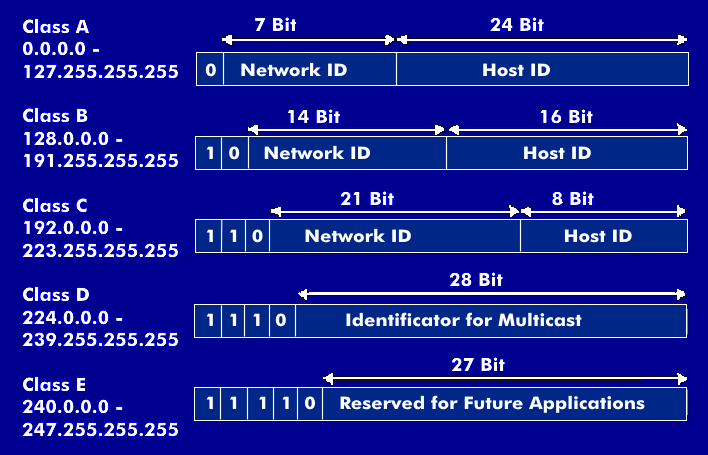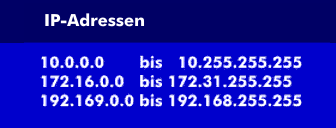IP address
The IP address is a 32-bit address for identifying a communication unit in an IP network. It consists of an address part for the network identifier( net-id) and the user part for the host identifier( host-id). The first bits define the network class. The network part can be between 7 bits and 21 bits long, depending on the network class, and is used for the network identifier (netid). The user part is used for the host identifier and can be between 8 bits and 24 bits long.
Each device connected to the Internet is assigned a unique IP address for identification purposes. All connected devices can communicate with each other via this address.
Originally, the IP address consisted of 8 bits for the network address and 24 bits for the subscriber address. This meant that only 256 networks could be addressed. For this reason, RFC 791 divided the addressing space into three and later into five different classes, which are designated by the letters A, B, C, D, and E. The first class is the IP address. Classes A, B and C differ in the different lengths of the network and user identification fields, while class D is reserved for IP multicast. In addition, the addressing specifications for the different classes differ from each other. IP addresses are written in dotted decimal notation, which is converted into domain names in the DNS system.
Class A address: Class A address is suitable for users who have few networks and many computers. It is characterized by the most significant bit( MSB), which is a "0". This means that the addresses are in the range from 0.0.0.0 to 127.255.255.255. The network indicator (net-id) is coded by 8 bits (with prefix) or 7 bits, which results in 128 different networks. The number of possible IP addresses within a network results from the 24 bits, which corresponds to 16,777,216. For this reason, these addresses are also only assigned to particularly large users.
Class B address: Address class B is interesting for users with a medium distribution of networks and computers. Class B addresses are identified by the two-bit combination "10". The address range extends from 128.0.0.0 to 191.255.255.255. The network ID is 16 or 14 bits long, which corresponds to a theoretical network number of 16,384 networks. The number of possible nodes within a network is 65,534 with 16 bits.
Class C address: Address class C is suitable for companies with many networks and few computers. It is identified by the prefix 110. Addresses of this class lie in the range from 192.0.0.0 to 223.255.255.255. The 24 or 21 bit network identification theoretically enables the unique identification of 2,097,152 different networks with 256 nodes each. This class is particularly interesting for small companies. Addresses in this category are no longer assigned due to address scarcity.
Class D address: The identifier for class D IP addresses is the bit combination 1110. The address range goes from 224.0.0.0 to 239.255.255.255. Due to the 28 bit long identifier for the multicast groups, the formation of up to 268,435,456 groups is possible.
Class E address: Class E identifier is the presented bit combination 11110 in the five highest order bits. Class E addresses are reserved addresses for future applications. The address range is from 240.0.0.0 to 255.255.255.255.
An Internet address identifies a computer on the network. Computers with multiple physical connections have multiple addresses. An address with the number 0 identifies a network. Addresses in which every bit is set to "1" are reserved for broadcast messages.
IP addresses in decimal notation
A disadvantage of this scheme is the change of location of a computer, because from one network to another the internet address of the computer changes. The notation of Internet addresses is generally such that each byte is represented as a decimal number and is separated from the neighboring byte by a dot (e.g. 194.175.131.2). Each network connected to the Internet is thus assigned a specific network identifier (net-id); the associated user identifiers can be assigned by the local network operator itself.
The decimal notation shown here, where the individual address blocks are separated by dots, is called Dotted Decimal Notation. Since these numeric Internet addresses are not informative with regard to the location and are also difficult to remember, it has been agreed to use hierarchical alphanumeric Internet names for the address representation. These addresses then look as follows, for example: "www.itwissen.de" or "www.zdfmsn.de". The Internet names are directly related to the Internet address. The conversion from one to the other and vice versa can be done via host tables or via worldwide valid DNS servers. The address structures are described in RFCs 1597, 1814 and 1918, with RFC 1918 specifying the address ranges reserved by IANA for private networks.
Since the classic IP addressing system was relatively static and many millions of addresses were given away in the given addressing options, the IP classes were replaced by Classless Interdomain Routing( CIDR) as early as 1993. This procedure is used in the IPv4 address and the IPv6 address.
IP addresses that are assigned when the devices are configured and do not change are called static IP addresses. Dynamic IP addresses, on the other hand, are those that are assigned dynamically using Dynamic Host Configuration Protocol( DHCP).


